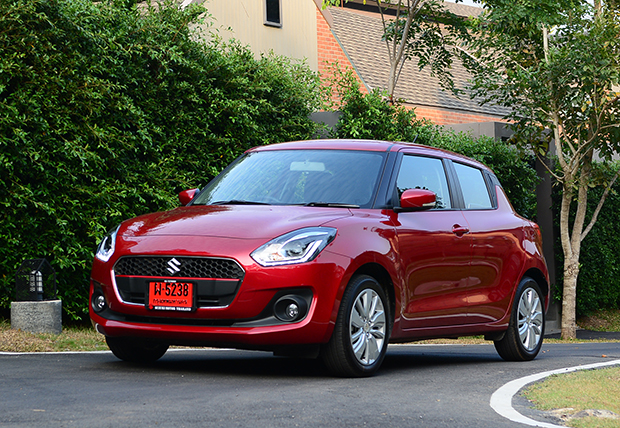There are many things to like about Suzuki’s latest-generation Swift, but it isn’t a class-act yet.

For the past six years or so, the Suzuki Swift had always been a reasonable choice in the B-segment class of Ecocar hatchbacks thanks to decent driving manners and a distinctive appearance.
In fact, Suzuki has earned a reputation of making good small cars for the masses. And thanks to Thai assembly, the Swift managed to sell in quite large numbers, although not to the extent of topping the sales chart with leaders Honda and Toyota.
Because of that, the all-new Swift that was just launched in the Thai market this month hasn’t been radically overhauled.
Mind, though, the changes applied in the latest-generation model extends from everything visual to mechanical.

The design DNA, for one, has carefully evolved so that it wouldn’t scare away existing clients. The most notable change would be no other than the rear door handles being placed on the distinctively penned C-pillars. It might not be to all tastes, but the Swift somehow manages to retain its identity quite well.
Changes inside the car seem to take a more consistently positive stride. The dashboard, especially the classy instrument panel behind the nice-looking steering wheel, looks and works far better than before. It’s just a shame that there’s not a single bit of plastic that has a soft-to-touch feel.
There’s a new infotainment touchscreen for the range-topping model to accommodate navigation system and smartphone connectivity via the brand’s Suzuki Smart Connect system. For 20,000 baht less, the 609,000 baht GLX gets a normal display but maintains the LED lights, 16-inch mag wheels, all-round disc brakes and the passive safety count of six airbags.
Sure, many buyers might be tempted for the lesser GL (536,000 baht) or GA (499,000) trims. But both are real cost-cutters by having just two airbags, halogen lamps, 15-inch steel wheels covered with hubcaps and an array of other small details. Which is why we’d recommend either of the top two grades because they are quite well-equipped for the money when compared to its competition.
Although the Swift has grown in length and width (you can really note its broader stance on the road), cabin and boot space is merely ample rather than having an ambition to topple the Toyota Yaris when it comes to outright practicality. Plus, the boot floor isn’t flat when the rear seats fold down and the loading lip itself is quite high in relation to the cargo floor.
The Swift sits a new platform called Heartect which, according to company executives, will eventually underpin other future models in the B-segment be it saloon (next Ciaz), MPV (all-new Ertiga) or SUV (yet to be seen baby crossover).

Raised rear door handles is main design change.
Engineers claims a 60-85kg reduction in overall weight, although the exact dietary regimen hasn’t been disclosed. Nevertheless, a dry weight of 875-910kg depending on grade is quite an achievement for a car of this class that has found the need to grow in size.
Car buyers who like surfing the net will also note that the Swift is sold with several engines to choose from in other markets like normally aspirated 1.2-litre four-cylinder petrol, turbocharged 1.0-litre triple or mild hybrid. But as the Thai Suzuki office only needs to make the Swift attract Ecocar Phase II rules, it has conveniently sidestepped the turbocharged and electrified units in favour of the more cost-effective 1.2-litre.
However, the 1.2-litre block is a new development despite sounding familiar in size with the previous Swift. It gets twin injectors per cylinder and dual variable valve-timing control.
In layman terms, this so-called Dualjet motor has been designed to enhance fuel economy. And because the Swift has moved away from Ecocar Phase I to II regs, it needs to achieve at least 23.3kpl and no more than 100g/km of that black soot coming out of the tailpipe.
Which is why power and torque outputs have marginally dropped to 83hp and 108Nm from 91hp and 118Nm. But since the Swift now has a lighter body, Suzuki says performance has hardly been blunted.

New engine is more frugal than the old one.
In fact, they seem to right after getting behind the wheel of the Swift at the driving trials held in Chiang Mai last week. Despite eight ponies having escaped from the engine room, the Swift performs very similarly as before, that is, ample in the city and kind of breathless elsewhere. You can set the CVT automatic into Sport mode, but it only helps a little in making the engine more responsive.
Like practically all other Ecocars currently on sale, the Swift prioritises fuel economy over performance. And it’s here where the improved drivetrain pays off. The 3kpl or so claimed decrease in fuel consumption seems justified meaning that in our typical driving style, the average rate has gone up from 17-18kpl to 20-21kpl. Stick to a steady 90kph and 25kpl is possible. That said, the Swift now joins the Mazda 2 in striking the best balance between performance and fuel efficiency in their class.
But there’s clearly one thing the Swift can’t beat the 2: the handling and ride balance. Yes, the Swift’s bigger footprint means that it feels significantly more planted to the road than before, but the light steering could have had a sharper initial turn-in and a more consistent feel when gliding swiftly in corners. The 2 seems to offer better weight and feels more natural. Even so, the Swift remains an easy car to steer for people with restrained driving styles.

Swift is cheaper in price than the Mazda 2.
And while the ride is generally comfortable, those Bridgestone tyres rimming the 16-inch wheels occasionally thump over sharp ruts and roar a little too much on rough road surfaces. The Yaris appears to have better rolling refinement.
And when combined with all other aspects of the car, the Swift isn’t a class-act yet. It somehow tends to give and take in some areas when measured with its opposition.
As some examples, the Swift is more competitively priced but not as good to drive as the Mazda, or it’s more fuel-efficient but not as roomy or comfy as the Toyota.
But those two aforementioned rivals are just among a few worth considering. The Swift is a much better and more desirable car than the Honda Brio, MG 3 (a non-Ecocar but with prices to match), Mitsubishi Mirage and Nissan Note (the March is already replaced elsewhere).
In the end, the Swift isn’t the best around but is above the class average. In the typical fashion of Suzuki in Thailand, the transformation in becoming a better car and selling more than ever is gentle rather than swift. At least, the stride is clearly positive.













